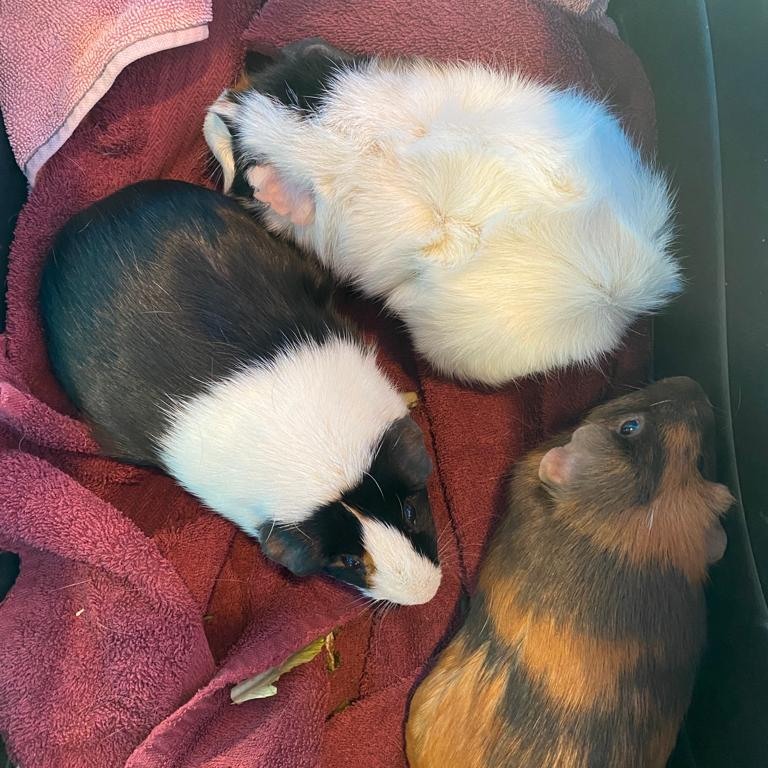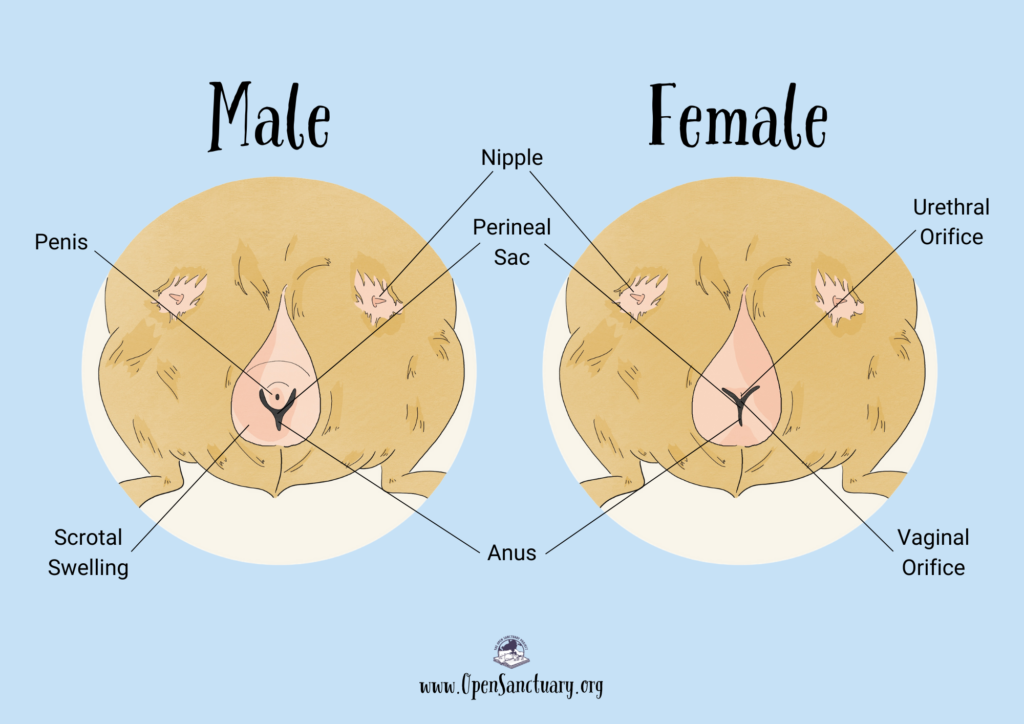
Introduction
What’s In A Name?
While guinea pig is a common name for Cavia porcellus, they are also commonly called cavies (singular, cavy). In this resource, we will be using ‘cavy’ instead of ‘guinea pig’ because of the way the term ‘guinea pig’ has been used to describe individuals exploited in scientific settings and also because, while no one knows where the name ‘guinea pig’ came from, one theory is that it stems from comparisons between consuming the flesh of cavies and the flesh of piglets. Problematic history and connotation aside, the name ‘cavy’ makes more sense as it stems directly from their scientific name and because cavies are neither from Guinea nor are they related to pigs (though their Latin name does translate to “little pig”). Check out more information on language choices at The Open Sanctuary Project here!
Being able to distinguish between male and female residents at your animal organization is important for many reasons, but in particular because one of the most critical things that defines a farmed animal sanctuaryAn animal sanctuary that primarily cares for rescued animals that were farmed by humans. (versus a petting zooAn organization where animals, either rescued, bought, borrowed, or bred, are kept, typically for the benefit of human visitor interest.) is that sanctuaries do not, and should not breed animals or allow their residents to become pregnant or reproduce accidentally. In the case of certain species, distinguishing males from females can be fairly easy, but with other species, it can be trickier. Cavies are among the trickier species! But it’s particularly important to distinguish between male cavies (boars) and female cavies (sows), for several reasons! In this resource, we’ll explain why you should take the time to determine whether your cavy residents are boars or sows, and how you can do it!
Breeding Health Risks Specific To Cavies
As referenced above, breeding animals or allowing accidental reproduction is problematic in a farmed animalA species or specific breed of animal that is raised by humans for the use of their bodies or what comes from their bodies. sanctuary or rescue context due to the exploitative nature of the practice and the overwhelming need for homes for existing animals. When it comes to cavies, there are even more unique health and social considerations that make it important to take precautions to keep them from breeding.
Cavies can breed at very young ages. Boars mature sexually and can mate when they reach two to three months of age, and sows can mature at two months of age. In some cases, both boars and sows can mature even earlier! While females are most commonly fertile in the spring, they can also become fertile at any time of year, so separating boars and sows only during certain seasons is an ineffective way to prevent them from breeding. A sow’s gestation period ranges from 59 to 72 days. Cavy babies are born fully furred, with their eyes open, and with their teeth present. Sows begin a new cycle within about half a day of giving birth, at which point boars will attempt to mate with them again.
A Note On Spaying And Neutering
Spaying and neutering cavies is an effective way to prevent breeding, however, because cavies often do not react well to anesthesia or surgery, spaying and neutering can also present risks. In general, neutering boars is easier than spaying sows, but seeking out a skilled and qualified veterinarian is critical when it comes to getting these surgeries done on your cavy residents. To learn more about how to find appropriate veterinary care for your farmed animal sanctuary’s residents, check out our resource on the subject here! Another important point to remember is that if you neuter a boar, you should wait for six weeks before introducing him to female companions, as he may still be able to breed during that period after surgery.
It’s also important to note that as baby sows grow up, their physiology changes. They have tough fibrous cartilage between the two pubic bones of their pelvises. When they reach adulthood, this cartilage stiffens, and their pelvises become less flexible. Once they have reached eight months of age, this stiffening means that should they become pregnant, it is highly unlikely that they can deliver their babies naturally. Cavies are small mammals and are also particularly sensitive to anesthesia. As a result, Cesarean sections are extremely risky procedures for them. So, should an adult sow become pregnant, it presents a life-threatening risk to her. Further, veterinarians have noted that sows who have litters often face shorter-than-average lifespans than those who do not.
With these facts in mind, it might occur to caregivers that the safest way to prevent cavies from breeding is to keep them alone. However, there are a few reasons that this isn’t a great solution, which we’ll discuss next!
The Social Needs Of Cavies And How Their Sex Impacts Their Social Interactions
In our resource on the introductory care of cavies, we discuss their unique social lives. To elaborate a bit further, wild living cavies live in close family groups of five to ten individuals. In some cases, such family groups may live near one another, making a larger colony. They behave as herd animals, maintaining a strict dominance ranking; a single, dominant male generally serves as the head of a harem of females.
DomesticatedAdapted over time (as by selective breeding) from a wild or natural state to life in close association with and to the benefit of humans cavies share these behaviors, and are extremely social animals who thrive living in small social groups. Single cavies can suffer from loneliness, stress, and behavioral issues. While every cavy is an individual, there are a few general patterns that happy social groups tend to fall into. They can consist of a primary boar and a few sows. In this case, you must ensure that the boar is neutered! Properly introduced neutered boars, or neutered boars who grew up with one another can also coexist with one another. Strictly sow groups can do well with one another too!
As a result of their social dynamics, determining the sex of your cavy residents is not just important to prevent breeding, but also because it plays a critical role in establishing successful and harmonious social groups! So let’s get down to “business” and discuss how to distinguish the boars from the sows!
Distinguishing Male And Female Cavies
Boars and sows cannot be told apart from above. Generally, boars tend to be slightly larger than sows, but different breeds come in different sizes, so you cannot conclusively determine whether a cavy is a boar or a sow based on size or weight. A few ounces difference in weight is not a conclusive measure of sex. Also, note that both boars and sows have nipples, so this is not determinative either! To properly determine the sex of a cavy, their reproductive organs have to be assessed. Make sure to check out our tips on how to safely handle a cavy in our introductory care guide here!
It is easiest to determine the sex of an adult intact boar, as their testicles are generally visible behind their rear legs. If these two distinct oval protrusions are not visible, the cavy will have to be held up or flipped over to be assessed. Cavies generally dislike being flipped over, but this may be necessary to determine whether an individual is a boar or a sow.
Because cavies don’t like being flipped, familiarize yourself with the below diagram prior to assessing them, so you can minimize the time they must be held in this way. A sow will have a genital area that resembles a “Y” shape while a boar will have more of an “i” shape. The dot on the “i” is the penis, and you can confirm the cavy is male by applying slight pressure above the genitals. If the dot sticks out further, you can be fairly confident you have a boar.

While you are handling your cavy residents, consider conducting a full health checkThe Open Sanctuary Project uses the term "health check" to describe health evaluations performed by caregivers who are not licensed veterinarians. While regular health checks are an important part of animal care, they are not meant to be a replacement for a physical exam performed by a licensed veterinarian. on them to make sure that nothing else is going on with them! To learn about cavy health checks, you can check out our cavy health check resource here!
Conclusion
When it comes to cavy residents, distinguishing the sows from the boars will not only prevent breeding but will also go a long way to determining what individuals can peacefully coexist with one another! As social and herd animals, taking this simple step can go a long way to ensuring that this gregarious and engaging small mammal species not only survives at your sanctuary but thrives!
SOURCES:
Why Residents Shouldn’t Breed At A Farmed Animal Sanctuary | The Open Sanctuary Project
Introductory Care For Cavies (Guinea Pigs) | The Open Sanctuary Project
How To Conduct A Cavy (Guinea Pig) Health Check | The Open Sanctuary Project
A Couple Of Cavies – Companionship For Your Guinea Pigs | Guinea Pig Awareness Week
Breeding And Reproduction Of Guinea Pigs | Merck Veterinary Manual (Non-Compassionate Source)
Care Of Guinea Pigs | Purdue University College Of Veterinary Medicine (Non-Compassionate Source)
Non-Compassionate Source?
If a source includes the (Non-Compassionate Source) tag, it means that we do not endorse that particular source’s views about animals, even if some of their insights are valuable from a care perspective. See a more detailed explanation here.








